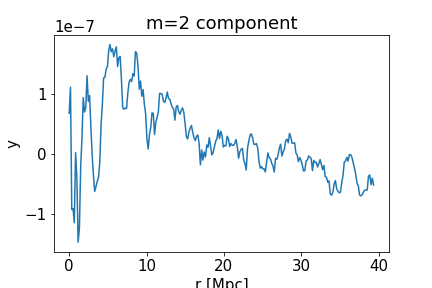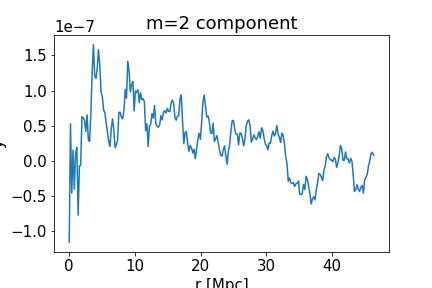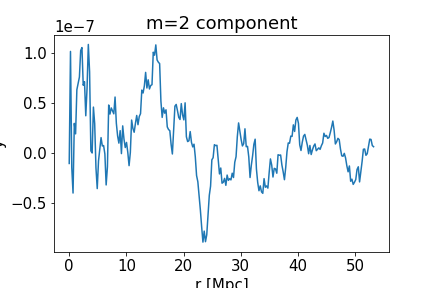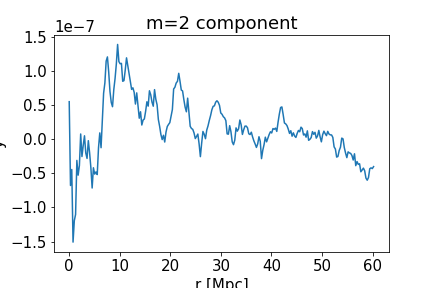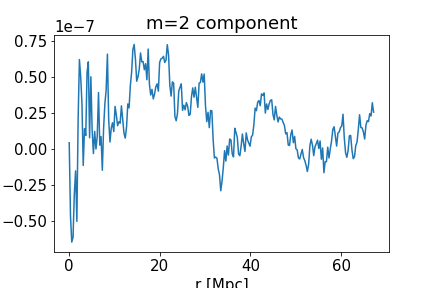Difference between revisions of "Jan 13, 2020"
| Line 11: | Line 11: | ||
== Radial profiles and looking at changes with redshift == | == Radial profiles and looking at changes with redshift == | ||
| − | + | For all the stacks which went into the above combined stack, we can decompose them into multipoles. The variation of the m=2 component with the radial coordinate, when phi=0, is shown below. | |
[[File:Actplanck rmlambda7to200 HESSIANon54a cmassredmagic 1032to1232Mpc meq2 e0to2on54a 570pts.png | frame|none|alt=Alt text | 1032 to 1232 Mpc, 570 points]] | [[File:Actplanck rmlambda7to200 HESSIANon54a cmassredmagic 1032to1232Mpc meq2 e0to2on54a 570pts.png | frame|none|alt=Alt text | 1032 to 1232 Mpc, 570 points]] | ||
| Line 18: | Line 18: | ||
[[File:Actplanck rmlambda7to200 HESSIANon35a cmassredmagic 1632to1832Mpc meq2 e0to2on35a 1038pts.png | frame|none|alt=Alt text | 1632 to 1832 Mpc, 1038 points]] | [[File:Actplanck rmlambda7to200 HESSIANon35a cmassredmagic 1632to1832Mpc meq2 e0to2on35a 1038pts.png | frame|none|alt=Alt text | 1632 to 1832 Mpc, 1038 points]] | ||
[[File:Actplanck rmlambda7to200 HESSIANon32a cmassredmagic 1832to2032Mpc meq2 e0to2on32a 1202pts.png | frame|none|alt=Alt text | 1832 to 2032 Mpc, 1202 points]] | [[File:Actplanck rmlambda7to200 HESSIANon32a cmassredmagic 1832to2032Mpc meq2 e0to2on32a 1202pts.png | frame|none|alt=Alt text | 1832 to 2032 Mpc, 1202 points]] | ||
| − | |||
It would be interesting to make some measure of how the filamentary structure changes with redshift, e.g. in the distance range shown above. I don't know if this is possible given the SNR of the stacks, and I'm not sure about the best way to do this. We would want to compare stacks of the same number of clusters in each redshift slice. Currently, there are ~600 clusters in the 1000-1200 Mpc slice, and that number goes up with each slice to about 1200 in the 1800-2000 Mpc slice. So, say we were interested in the evolution from 2000 Mpc away until 1000 Mpc away (z~.52 to ~.24) we'd need to limit all slices to only 600 clusters per slice. Would probably want to do some random re-sampling of the clusters in each slice to get bootstrap errors. | It would be interesting to make some measure of how the filamentary structure changes with redshift, e.g. in the distance range shown above. I don't know if this is possible given the SNR of the stacks, and I'm not sure about the best way to do this. We would want to compare stacks of the same number of clusters in each redshift slice. Currently, there are ~600 clusters in the 1000-1200 Mpc slice, and that number goes up with each slice to about 1200 in the 1800-2000 Mpc slice. So, say we were interested in the evolution from 2000 Mpc away until 1000 Mpc away (z~.52 to ~.24) we'd need to limit all slices to only 600 clusters per slice. Would probably want to do some random re-sampling of the clusters in each slice to get bootstrap errors. | ||
Revision as of 06:08, 13 January 2020
Combining stacks of different redshifts
I've written a program to take the stacks of clusters in different 200Mpc slices, resize them all to the same physical size, and stack them. Below are plots showing the stack from one slice, then adding the stacks from each successively more distant slice. This combination helps to bring out the signal. These were all done using the combined CMASS and Redmagic galaxy maps for orientation, at an ~18 Mpc smoothing scale, with the ellipticity 0 < e < 2 (more written on the ellipticity later). In order, left to right and up to down, the images below start at the 1000-1200 Mpc slice, then add and average the successive 200 Mpc stacks until the final image is the average of 5 stacks in the 1000-2000 Mpc range.
Radial profiles and looking at changes with redshift
For all the stacks which went into the above combined stack, we can decompose them into multipoles. The variation of the m=2 component with the radial coordinate, when phi=0, is shown below.
It would be interesting to make some measure of how the filamentary structure changes with redshift, e.g. in the distance range shown above. I don't know if this is possible given the SNR of the stacks, and I'm not sure about the best way to do this. We would want to compare stacks of the same number of clusters in each redshift slice. Currently, there are ~600 clusters in the 1000-1200 Mpc slice, and that number goes up with each slice to about 1200 in the 1800-2000 Mpc slice. So, say we were interested in the evolution from 2000 Mpc away until 1000 Mpc away (z~.52 to ~.24) we'd need to limit all slices to only 600 clusters per slice. Would probably want to do some random re-sampling of the clusters in each slice to get bootstrap errors.
Importance of including Redmagic galaxies
Given Bhuvnesh's warning about how the Redmagic galaxy sample is difficult to mock, we had been wondering if it is possible to do this project with orientations given by the CMASS galaxy field alone. So, I tested stacks at various smoothing scales





